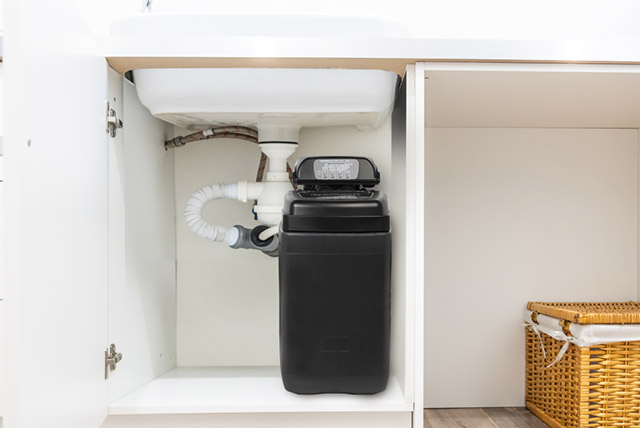Having a water softener in a Irish home is a true luxury. It banishes the dreaded hard water gremlins, leaving you with soft, luxurious water that makes everything from cleaning to showering a breeze. But just like any other appliance, your water softener needs a little upkeep to keep it functioning at its best.
This comprehensive guide will equip you with the knowledge and simple steps to keep your water softener working at its peak performance, ensuring it continues to provide your home with the benefits of soft water for years to come. Luckily, it’s relatively easy to care for your system.
1. Check Salt Levels (Once a Month)
Keeping the salt level in your water softener is crucial. Think of it like checking the oil in your car! Your water softener relies on tiny resin beads to capture hardness minerals from your water. Over time, these beads become full of the minerals they’ve trapped. To clean them and keep them working effectively, they need a salt water solution called brine. If you don’t regularly add water softener salt, the beads won’t be able to clean themselves properly, and you’ll start experiencing hard water problems again.
Here are some things to consider with water softener salt:
Top Up the Salt When Needed
Ideally, the salt level should be at least half full and reach a minimum of three inches above the water level.
As a rule of thumb, refill the salt when it is below a quarter full and make sure to never fill it more than two thirds full to prevent salt bridges.
Use appropriate type of salt
Just like your car needs the right fuel to run smoothly, your water softener needs the right type of salt to function optimally. Not all salt is created equal, and using the wrong kind can lead to problems down the line. Salt for a water softener can either be granular, tablet or in block form.
There are three main grades of water softener salt: rock salt, solar salt, and evaporated salt.
- Rock Salt: The least expensive option, rock salt contains impurities that can create a muddy brine tank, reduce softening efficiency, and leave traces of minerals in your softened water.
- Solar Salt: More soluble than rock salt, solar salt is a good mid-range option. It’s available in both pellet and crystal forms.
- Evaporated Salt: The purest option, evaporated salt boasts 99.99% sodium chloride. It dissolves easily, minimizing the risk of salt bridges and mushing, which can lead to maintenance issues.
Out of these three options, go with evaporated salt as it’s the purest form without any impurities. Water softener salt is easily available and can be purchased from most hardware stores.
Inspect the Brine Tank
During your monthly salt check, take a peek inside the brine tank. Look for any cloudiness, discolouration, or foreign objects. A cloudy brine can indicate a problem with the salt or the tank itself. If you notice anything unusual, contact a water treatment professional for further assistance.
2. Check for Salt Bridges (Once a Month)
A salt bridge occurs when a hard crust forms in the brine tank and creates an empty space between the water and the salt, preventing the salt from dissolving into the water to make brine. This can significantly hinder the regeneration process, compromising your water softener’s ability to deliver soft water.
Here’s how to prevent and address salt bridges:
- Don’t overfill: Keep the salt level in your brine tank to a maximum of two-thirds full. This allows salt to dissolve in water better and discourages salt bridging.
- Break it up: During your monthly salt check, if you see large, hard clumps of salt instead of loose granules, it might indicate a salt bridge forming. If a salt bridge forms, use a broom handle or a long stick to gently break it apart. You can also add warm water to the tank to loosen the salt before attempting to break the bridge.
3. Inspect the Venturi Valve (Once a Year)
The venturi valve is a small component within the control valve that plays a crucial role in creating the suction needed to draw brine into the system during regeneration. Over time, the venturi valve can become clogged with mineral deposits.
While cleaning the venturi valve can be done at home by you, it’s a more intricate task best suited for a water treatment professional. They can assess the valve’s condition and clean it if necessary.
4. Clean the Pre-filter (Every 6 Months)
If you rely on a private well, it’s most likely you have a pre-filter installed before the water enters the treatment system. If untreated water is allowed to enter the water softener, it would quickly clog and damage the system. A pre-filter protects the water softener by eliminating large contaminants, sand, and sediment commonly found in well water and usually lasts for 6 months depending on incoming water quality.
It therefore becomes essential to replace the pre-filter periodically to enhance the life of your water softener and operate at peak efficiency.
Service Your Water Softener Annually
A little care goes a long way in ensuring your water softener continues to deliver the benefits of soft water for years to come. Just like your car benefits from a regular service, your water softener can significantly benefit from an annual professional inspection and servicing.
Hydrotech Water Services offers annual water softener servicing where an experienced technician can conduct routine inspection on your water softener, optimise its settings, assess water flow, identify any worn-out parts, and clean the equipment if necessary.
Get in touch with our expert team to book a service for your water softener.

